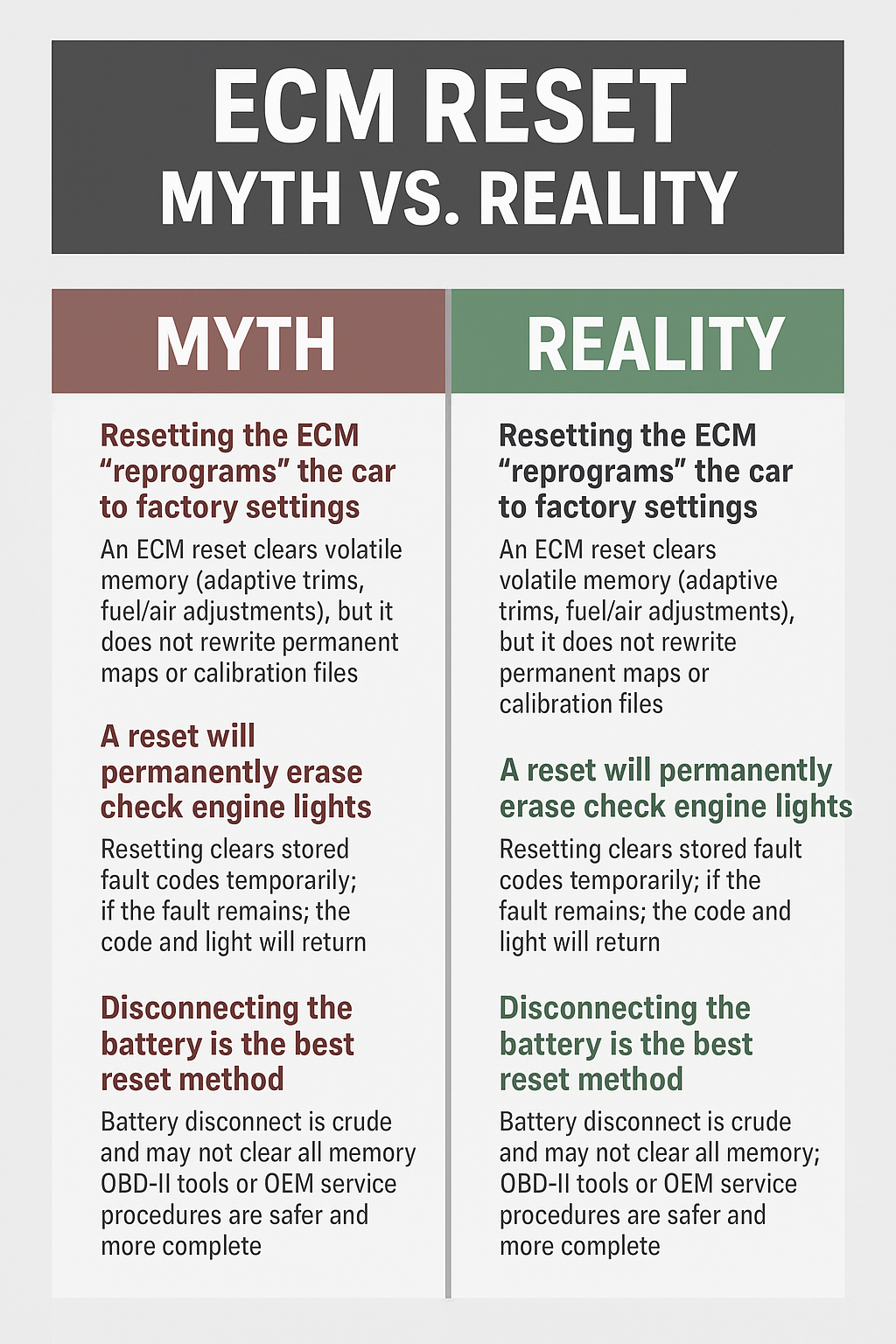Few topics stir more debate in car forums and garages than the Engine Control Module (ECM) reset. Some enthusiasts swear by it as a magic fix—claiming it boosts power, erases codes forever, or teaches the engine to run “like new.” Others dismiss it entirely. The truth? An ECM reset has real technical functions, but they are often misunderstood or exaggerated. To make smart repair decisions, you need to know what an ECM reset can and cannot do.
Contents
Myths vs. Reality: ECM Reset at a Glance
| Myth | Reality |
|---|---|
| Resetting the ECM “reprograms” the car to factory settings | An ECM reset clears volatile memory (adaptive trims, fuel/air adjustments), but it does not rewrite permanent maps or calibration files |
| A reset will permanently erase check engine lights | Resetting clears stored fault codes temporarily; if the fault remains, the code and light will return |
| Resetting improves horsepower or MPG instantly | Any gains felt are usually from adaptive trims being cleared; performance returns to baseline behavior, not beyond factory specs |
| Disconnecting the battery is the best reset method | Battery disconnect is crude and may not clear all memory; OBD-II tools or OEM service procedures are safer and more complete |
| A reset “fixes” rough idle, hesitation, or stalling | It may mask symptoms briefly, but underlying mechanical/electrical issues remain |
| All vehicles reset the same way | ECM behavior varies by manufacturer (e.g., GM vs. Honda vs. BMW); some need specific relearn procedures after a reset |
What an ECM Reset Actually Does
When you reset an ECM, you are wiping certain temporary, adaptive, and learned values stored in volatile memory. These may include:
- Fuel trims: Short- and long-term corrections the ECM makes to maintain proper air-fuel ratio.
- Idle and throttle position adaptives: Learned adjustments that keep idle smooth and throttle response consistent.
- Transmission shift adaptives (on some vehicles): Adjustments made to account for wear and driving style.
- Pending fault codes and freeze-frame data.
After a reset, the ECM starts fresh, recalculating these values as you drive. This process is often called a relearn or drive cycle.
What an ECM Reset Cannot Do
It’s equally important to know the limitations of a reset:
- ❌ It does not fix mechanical issues like vacuum leaks, misfires, bad sensors, or failing fuel pumps.
- ❌ It does not permanently erase fault codes if the underlying problem still exists.
- ❌ It does not rewrite OEM programming, fuel/ignition maps, or emissions strategies.
- ❌ It does not bypass immobilizer, security, or OEM logic controls.
Think of an ECM reset as clearing your computer’s RAM—not reinstalling its operating system.
ECM Reset Illustrative Myth vs. Reality Image

Real-World Examples
- When it helps:
- A Honda Civic owner replaces a faulty oxygen sensor. After repair, resetting the ECM clears the old fuel trims so the new sensor can be recognized immediately.
- A GM truck shows erratic idle after throttle body cleaning. Resetting forces the ECM to relearn idle air control parameters.
- When it doesn’t help:
- A BMW owner with a failing mass airflow sensor resets the ECM. The car runs fine for a few miles, then the check engine light returns. The reset only cleared the symptom, not the cause.
- A Toyota with a misfire due to worn spark plugs still misfires after an ECM reset—the mechanical fault remains.
Manufacturer Variations
Not all resets are equal. Different automakers have unique strategies:
- Honda/Acura: Often require idle/throttle relearn after reset. Failure to do so may cause rough idle.
- GM: ECM and transmission adaptives can be cleared separately using a scan tool.
- Toyota/Lexus: Clearing codes resets long-term fuel trims but may require multiple drive cycles for readiness monitors.
- BMW/Mini: Resetting often requires OEM-level software (ISTA), not just a generic OBD-II tool.
- Ford: Certain drive-by-wire models require a throttle body relearn after battery disconnect or reset.
How to Perform an ECM Reset Safely
Preferred Method (using OBD-II scanner):
- Connect an OBD-II scanner capable of clearing codes and adaptives.
- Select “Clear Codes” or “Reset ECM/ECU adaptives.”
- Turn the ignition off for 10–30 seconds.
- Restart the vehicle and follow the manufacturer’s drive cycle procedure for relearn.
Alternative (battery disconnect method):
- Turn off ignition and remove key.
- Disconnect the negative battery terminal for 15–30 minutes.
- Reconnect, then start the engine and allow it to idle for stabilization.
- Drive normally while the ECM relearns.
⚠️ Cautions:
- Do not reset ECMs repeatedly without addressing root issues—it delays proper diagnostics.
- Some vehicles may lose radio presets, clock settings, or even security immobilizer data after a full reset.
Practical Advice for DIYers and Technicians
- ✅ Use a quality OBD-II scanner rather than just disconnecting the battery.
- ✅ Perform a reset after repairs involving sensors, throttle body cleaning, or air/fuel components.
- ✅ Follow OEM drive cycle instructions to ensure readiness monitors reset for emissions testing.
- ❌ Do not rely on resets to “fix” ongoing issues—diagnose root causes with live data, fuel trim analysis, and component testing.
Conclusion: Myth Busted
An ECM reset is a tool, not a cure-all. It clears adaptive memory and fault codes, giving the ECM a clean slate to relearn operating parameters. But it does not reprogram the engine, magically restore performance, or fix broken components.
Takeaway: Use ECM resets wisely—after repairs, during diagnostics, or when relearns are necessary. However, remember that the real solution lies in identifying and correcting the underlying issue, not just wiping the slate clean.
